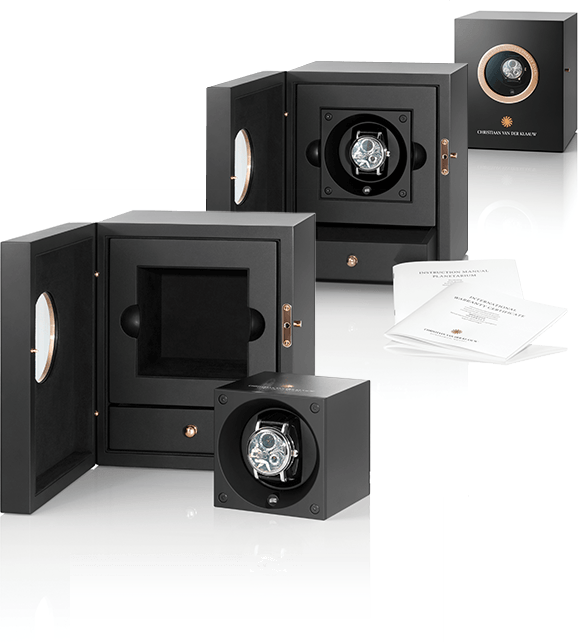THE CVDK PLANETARIUM
It contains the smallest mechanical Planetarium in the world, showing real time the orbits of Mercury, Venus, Earth, Mars, Jupiter and Saturn around the Sun.
THE CVDK PLANETARIUM
It contains the smallest mechanical Planetarium in the world, showing real time the orbits of Mercury, Venus, Earth, Mars, Jupiter and Saturn around the Sun.
CVDK PLANETARIUM CKPT33B4
TECHNICAL DETAILSMovementCVDK Manufacture Movement, automatic winding,32 jewels, power-reserve; 60 hour max., complication; CVDK Planetarium module.
FunctionsHours, minutes, complication; date, month, Planetarium; the watch is equipped with the smallest mechanical Planetarium in the world, showing the orbits of Mercury, Venus, Earth, Mars, Jupiter and Saturn around the Sun.
CaseHigh quality steel, ø 40 mm, sapphire crystal, sapphire crystal case-back.
DialAventurine glass in black (goldfluss) creating a star filled sky with white rhodium plated indexes, rhodium plated Planetarium with coloured Sun and Earth.
StrapBlack leather.
BuckleLogo engraved steel folding clasp.
THE MASTERPIECE
CVDK PLANETARIUM
This is the ultimate way to carry the universe closely to your heart. Our in-house designed module gives you the smallest mechanical heliocentric planetarium in the world. It displays real time the solar orbits of Mercury, Venus, Earth, Mars, Jupiter and Saturn. It also shows you the minutes, hours, date and month. The result is a magnificent spectacle that continues to fascinate in all its complex mechanical beauty.
This is astronomical watchmaking at the highest level, intricately designed and executed. Our Planetarium is one of the most complicated watches in our collection, a fitting tribute to the grand masters of planetarium design such as Nicolaas Copernicus, Johannes Kepler, Christiaan Huygens and Eise Eisinga.
This smallest mechanical Planetarium in the world is located at the 6 o’clock position. The Sun is positioned exactly in the middle of the Planetarium. The planet closest to the Sun is Mercury. Mercury is followed by Venus, Earth, Mars, Jupiter and Saturn. The planets orbit around the Sun as follows:
Mercury 87.97 days
Venus 224.70 days
Earth 365.24 days
Mars 686.98 days
Jupiter 11.86 years
Saturn 29.46 years
THE MASTERPIECE
CVDK PLANETARIUM
This is the ultimate way to carry the universe closely to your heart. Our in-house designed module gives you the smallest mechanical heliocentric planetarium in the world. It displays real time the solar orbits of Mercury, Venus, Earth, Mars, Jupiter and Saturn. It also shows you the minutes, hours, date and month. The result is a magnificent spectacle that continues to fascinate in all its complex mechanical beauty.
This is astronomical watchmaking at the highest level, intricately designed and executed. Our Planetarium is one of the most complicated watches in our collection, a fitting tribute to the grand masters of planetarium design such as Nicolaas Copernicus, Johannes Kepler, Christiaan Huygens and Eise Eisinga.
This smallest mechanical Planetarium in the world is located at the 6 o’clock position. The Sun is positioned exactly in the middle of the Planetarium. The planet closest to the Sun is Mercury. Mercury is followed by Venus, Earth, Mars, Jupiter and Saturn. The planets orbit around the Sun as follows:
Mercury 87.97 days
Venus 224.70 days
Earth 365.24 days
Mars 686.98 days
Jupiter 11.86 years
Saturn 29.46 years
ANIMATION
CVDK PLANETARIUM

the rotor
The striking rotor, crafted in the shape of the CVDK logo, is skeletonized and plated in rose gold.

OUR UNIVERSE
The Atelier produces only a limited number of watches every year. In this way, the artists of Christiaan van der Klaauw Astronomical Watches can give every watch the attention it deserves. This attention is reflected in the beauty and quality of the watch. All watches are made by hand and subjected to countless quality tests. Christiaan van der Klaauw are therefore so convinced of the quality of their products, that they give a three-year warranty on the movement and the case.
All Christiaan van der Klaauw watches are delivered in an exclusive luxurious watch box.
For the Collection of the Astronomical Masterpieces the watch box is also fitted with a Swiss Kubik winder. This winder, which can be removed from the box, will ensure that your astronomical complication stays accurate.



